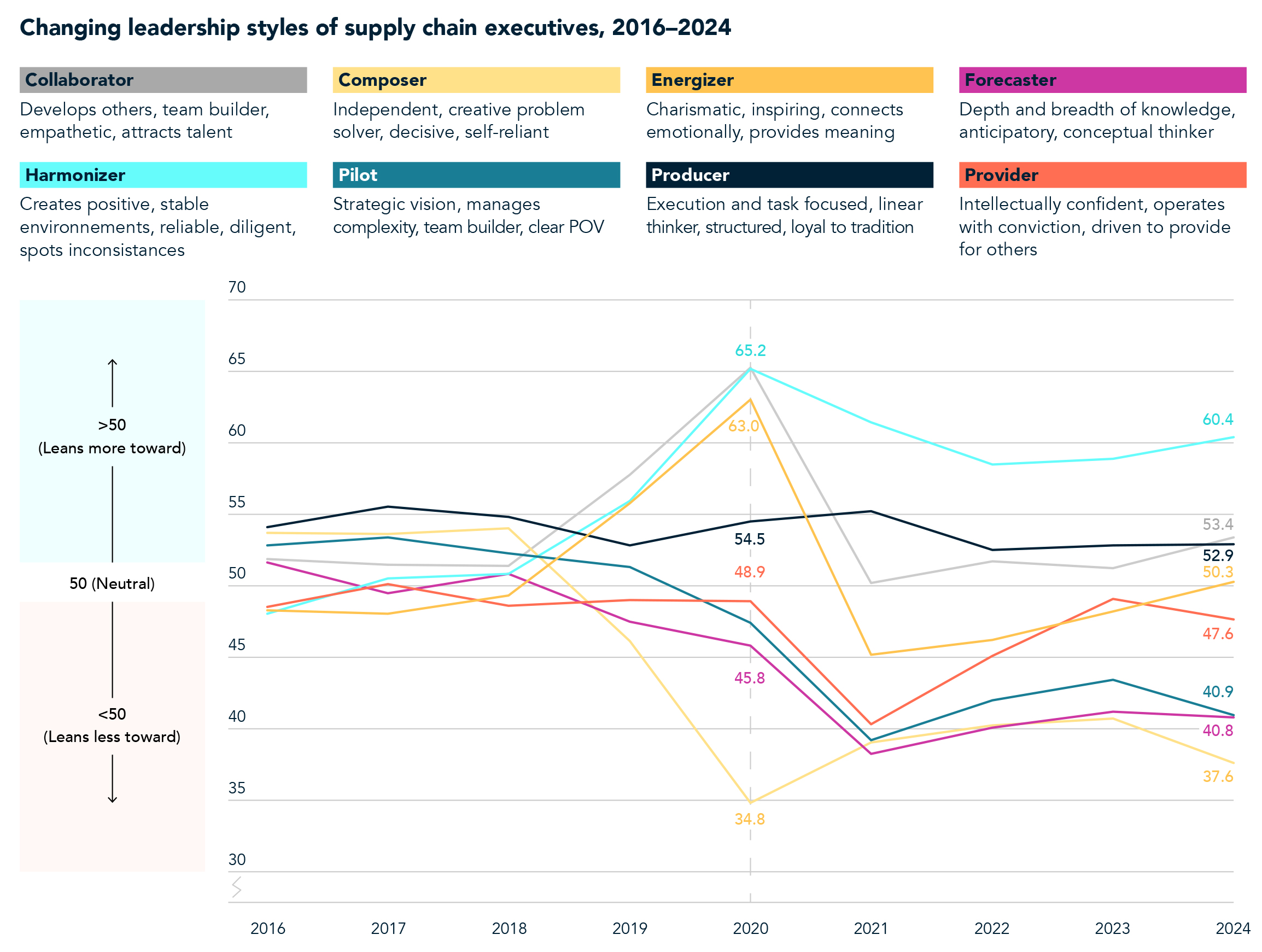Supply Chain & Operations Officers
The changing leadership styles of supply chain executives, 2016–2024
Since 2016, more than 5,000 supply chain executives have taken a proprietary Heidrick & Struggles survey1—the combined results of which highlight how much each leader tends toward each of the eight styles of leadership (see chart, “Changing leadership styles of supply chain executives, 2016–2024”).
In 2016, the scores across styles varied little, meaning that supply chain leaders overall used a broad range of styles. Between 2016 and 2019, the share of executives who were more often working as collaborators, energizers, and harmonizers grew fairly steadily, while those tending toward being composers, forecasters, and pilots fell. The core executional focus, which sits with the producer style, changed little.
The shock of the pandemic hit supply chain executives as hard as any, as industries from consumer goods to agriculture scrambled to provide for unforeseen needs and work in life sciences took on unprecedented urgency. As a result, the supply chain function became more strategically important in most companies and the previous leadership trends accelerated significantly: we saw that the collaborator, the energizer, and the harmonizer leadership styles had become significantly more common among the executives we surveyed. And these leadership styles, though having declined in need somewhat as the world has adapted to the impacts of the pandemic, have remained more common to this day, pointing to a new normal for leadership in the supply chain function.
Supply chain leadership: Evolving needs and challenges
The composer mindset, while still relevant, has become less dominant as supply chain functions evolve from a back-end focus to a more collaborative approach. Today’s CSCOs must work seamlessly with other business functions to drive a unified strategy.
The forecaster’s depth of knowledge remains valuable, but the rapidly changing market demands leaders who are agile and adept at addressing new challenges as they arise.
The pilot mindset has also seen a reduced emphasis, similar to the forecaster, as leaders focus on resolving existing backlogs and managing immediate priorities. Only after addressing these challenges can they fully transition to a future-oriented perspective.
In 2020, we hypothesized that the need for supply chain leaders who can transform both their supply chains and their functions would further increase, and that this new generation of leaders would need to be able to navigate constantly changing technology, automation, and engineering tools, as well as adeptly use data and analytics to drive decisions. We argued that this increasing need would be driven by omnichannel consumer requirements and e-commerce-driven supply, along with the entry of new competitors into virtually every sector—making it harder for companies to accurately build supply and demand forecasts (especially in long lead time manufacturing environments).
While this still holds true, it is notable that we have seen the collaborator leader rise in prominence once more, pointing to the growing need for strong people leaders as well. The collaborator, with their empathy and team-building skills, is a leader who can create unity through transition and drive a purpose-driven organizational culture through a focus on developing others.
And, while operations have somewhat stabilized post-pandemic, the harmonizer’s ability to create and sustain a high-energy culture remains a priority as a supply chain executive for driving engagement, productivity, and transformation. The harmonizer, whose reliability and diligence work together to create a stable environment, is, unsurprisingly, particularly valuable in uncertain economic and geopolitical conditions, not to mention in the face of looming challenges and disruptions caused by climate change.
Finally, we have also noted that producer leadership has become more common—that is, leaders who are execution and task focused, linear thinkers, structured, and loyal to tradition—suggesting that traditional leadership skills are still highly valued in the function.
The chief supply chain officer’s knowledge of the intricacies of the function must now be matched with their ability to navigate an uncertain future and keep up with fast-moving digital and technological innovations. Agility will be key, as will communication skills. Leaders and aspiring leaders can best position themselves for the future by examining their own leadership styles and strengths and considering how they can develop those to adapt to a broadening scope of responsibility.
About the authors
Scott Adams (sadams@heidrick.com) is the partner-in-charge of Heidrick & Struggles’ Atlanta office and a member of the global Consumer Markets and Supply Chain & Operations Officers practices.
Daniel Colaco (dcolaco@heidrick.com) is an engagement manager in the Toronto office and a member of the global Consumer Markets and Supply Chain & Operations Officers practices.
Reference
1 To learn more about Heidrick & Struggles’ Leadership Signature survey, see Karen Rosa West, "What's your leadership signature?" Heidrick & Struggles.
